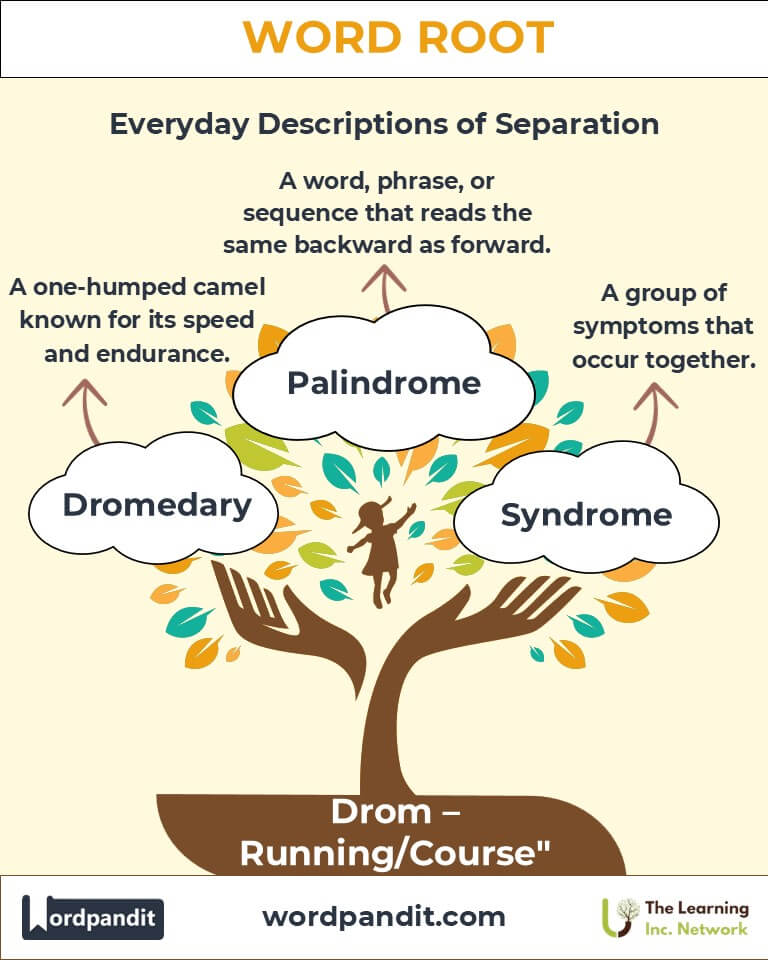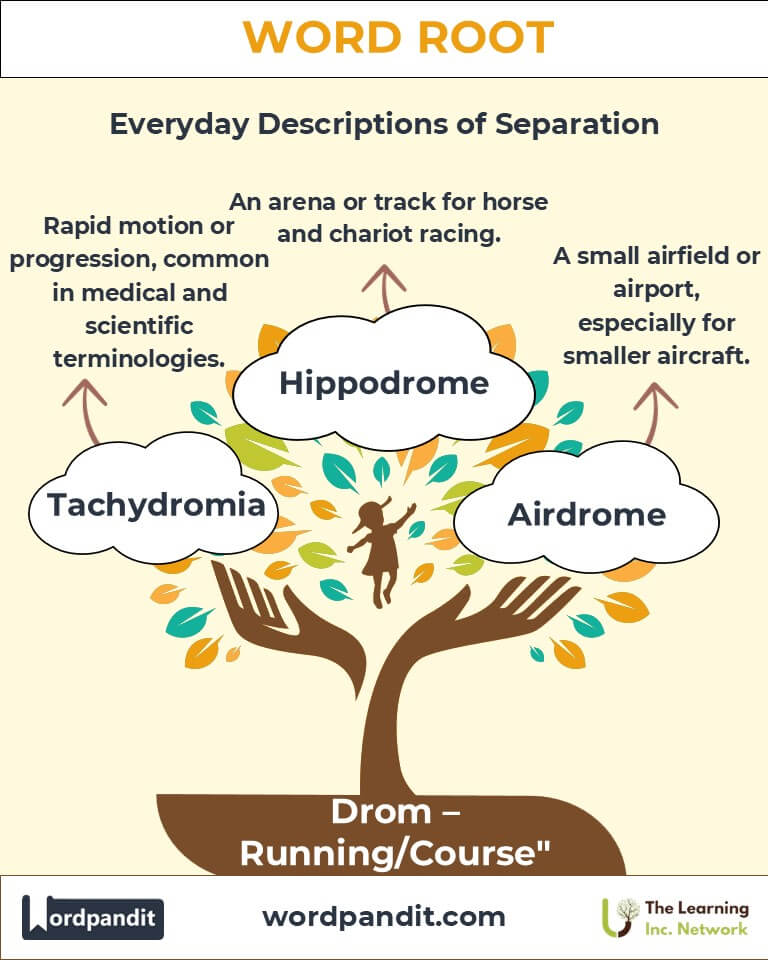Drom: The Art of Running and Movement in Language
Discover the dynamic energy of the word root "drom," derived from Greek, meaning "running" or "course." This root powers words like "syndrome" and "palindrome," reflecting paths, patterns, and motions across disciplines like medicine, literature, and everyday language.

Table of Contents
- Introduction: The Essence of Drom
- Etymology and Historical Journey
- Mnemonic: Unlocking the Power of Drom
- Common Drom-Related Terms
- Drom Through Time
- Drom in Specialized Fields
- Illustrative Story: Drom in Action
- Cultural Significance of Drom
- The Drom Family Tree
- FAQs about the Drom Word Root
- Test Your Knowledge: Drom Mastery Quiz
- Conclusion: The Living Legacy of Drom
Introduction: The Essence of Drom
The word root "drom," pronounced "drahm," captures the spirit of running, movement, or a defined course. This Greek root forms the foundation of terms spanning from medical conditions (syndrome) to literary curiosities (palindrome). Whether it's a literal race or the metaphorical journey of ideas, "drom" embodies dynamic progress and structure.

Etymology and Historical Journey
The root "drom" traces back to the ancient Greek word dromos, meaning "course" or "race." It was commonly used to describe running tracks and arenas, such as those used in ancient Olympic games. Over time, "drom" transcended its athletic origins, evolving into abstract meanings that signify paths or patterns, eventually finding its way into scientific and literary contexts.
Mnemonic: Unlocking the Power of Drom
Imagine a runner racing down a circular track, symbolizing the unending loops of movement and repetition found in words like palindrome.
Mnemonic Device: "Drom drives the course—running through races, patterns, and life."
Common Drom-Related Terms
- Syndrome (sin-drohm): A group of symptoms that occur together.
- Example: "Down syndrome is characterized by a distinct set of physical and developmental traits."
- Palindrome (pal-in-drohm): A word, phrase, or sequence that reads the same backward as forward.
- Example: "The word 'madam' is a classic palindrome."
- Hippodrome (hip-uh-drohm): An arena or track for horse and chariot racing.
- Example: "The ancient hippodrome was the heart of sports in Byzantine cities."
- Dromedary (drom-uh-der-ee): A type of camel known for its speed, having one hump.
- Example: "The dromedary is often called the 'ship of the desert' for its endurance."
- Airdrome (air-drohm): An airfield, especially a small airport.
- Example: "The remote airdrome serves as a refueling stop for small planes."
Drom Through Time
- Hippodrome (Ancient Greece): Initially a physical racetrack, it evolved to describe grand arenas where entertainment, sports, and politics converged.
- Syndrome (Medical Modernity): While the root focuses on patterns, its adaptation to medicine emphasizes interconnected symptoms—a metaphorical “path” within the human body.
Drom in Specialized Fields
- Medicine: Syndrome helps identify and classify interconnected health patterns.
- Application: Enables better diagnosis and treatment plans.
- Linguistics: Palindrome explores symmetry in language.
- Example: Used to create artistic wordplay in poetry and puzzles.
- Transportation: Dromedary is a symbol of swift, enduring movement.
- Impact: Represents innovation in design, from ancient caravans to modern logistics.
- Aviation: Airdrome highlights the practical application of "drom" in infrastructure.
- Relevance: Marks innovation in transport and communication.
Illustrative Story: Drom in Action
Amira was fascinated by the concept of "drom." She admired dromedaries for their resilience, memorized palindromes for their symmetry, and marveled at how syndromes mapped complex human experiences. When she participated in a charity race at the local hippodrome, Amira felt a profound connection to the root—running not just for the prize but for the joy of following life's courses.
Cultural Significance of Drom
From the ancient hippodromes of Greece to the modern fascination with palindromes, "drom" symbolizes movement, rhythm, and balance. It connects the athleticism of the past with the intellectual pursuits of the present, reflecting humanity’s enduring fascination with patterns and progress.

The Drom Family Tree
- Tachy- (Fast):
- Example: Tachydromia: Rapid motion or progression.
- Common Use: Found in medical and scientific terminology.
- Meta- (Change):
- Example: Metadrome: A course that changes direction.
- Application: Illustrates philosophical or narrative shifts.
- Hypo- (Under):
- Example: Hypodrome: A subtle, underlying pattern.
- Application: Describes faint trends in data analysis.

FAQs About the "Drom" Root
Q: What does "drom" mean?
A: It means “running” or “course,” originating from the Greek word dromos.
Expanded Explanation: This root embodies the concept of movement, whether literal, like in a race, or metaphorical, such as patterns in syndromes or palindromes.
Q: What is a palindrome?
A: A word, phrase, or sequence that reads the same backward as forward, like “level” or “racecar.”
Expanded Explanation: The term comes from palin (again) and dromos (course), indicating a word or phrase that retraces its "course" symmetrically.
Q: What is the meaning of syndrome?
A: A group of symptoms that consistently occur together, forming a pattern.
Expanded Explanation: The word combines syn (together) and dromos (course), meaning symptoms that “run together” to signify a condition or disorder.
Q: What’s the historical significance of the hippodrome?
A: It was an ancient Greek or Roman stadium for horse and chariot racing.
Expanded Explanation: The word combines hippo (horse) and dromos (course), showing its role as a racecourse for equestrian events.
Q: What is a dromedary, and why is it named so?
A: A one-humped camel, known for its swiftness and endurance.
Expanded Explanation: The name originates from the root drom, referring to its ability to “run” long distances quickly in desert conditions.
Q: What is an airdrome?
A: A small airfield or airport, especially for smaller aircraft.
Expanded Explanation: Combining air and dromos (course), it signifies a “running course” for planes.
Q: How does drom relate to patterns or movement in language?
A: It highlights repetition and symmetry, as seen in palindrome.
Expanded Explanation: The concept of retracing or following a defined path links to the aesthetic appeal of structured language.
Q: Why does syndrome emphasize connected symptoms?
A: Because it represents multiple symptoms that occur together in a predictable way.
Expanded Explanation: This reflects the Greek root’s association with movement, symbolizing how symptoms “run together” to define a condition.
Test Your Knowledge: Drom Mastery Quiz
1. What does drom signify?
2. Which word describes an animal associated with speed?
3. What does a syndrome represent?
4. Which term describes a word that reads the same backward and forward?
5. What does hippodrome historically refer to?
Conclusion: The Living Legacy of Drom
The root "drom" reminds us of the universal nature of movement and structure. From racetracks to repeating patterns, it enriches language and thought across time and disciplines. As we embrace "drom" in words like syndrome and palindrome, we celebrate the dynamic courses that shape our understanding of the world.












